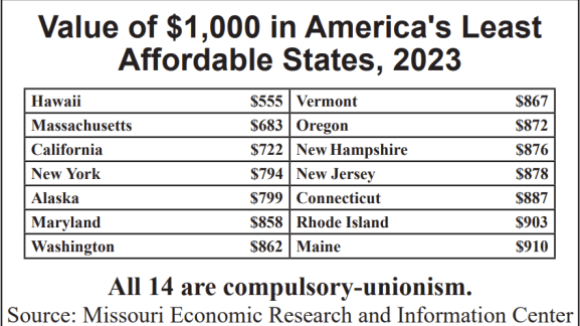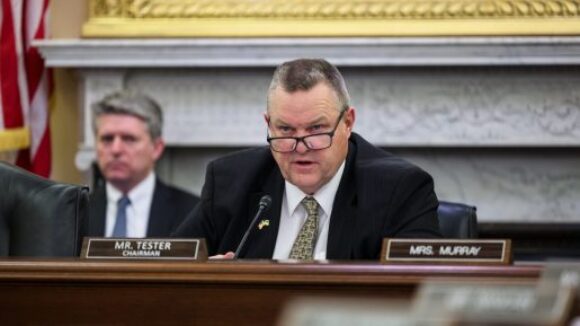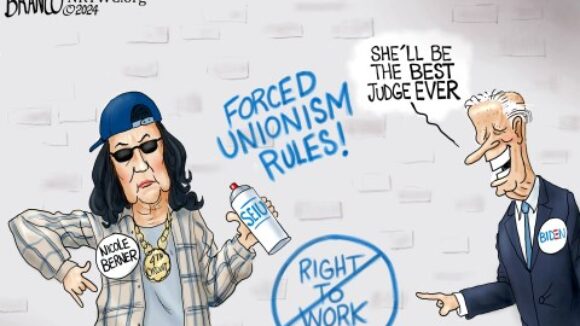Banning Compulsory Dues Curbs Cost of Living
On average, forced-unionism states are 23.2% more expensive to live in than Right to Work states. And decades of academic research show that compulsory unionism actually fosters a higher cost of living.
 Trey Kovacs looks at Minnesota Governor Mark Dayton’s quest to empower union bosses by any means necessary:
Trey Kovacs looks at Minnesota Governor Mark Dayton’s quest to empower union bosses by any means necessary:
Minnesota State Senator Mike Parry (R-Waseca) recently caused a stir with strong accusations against Governor Mark Dayton. “It’s no secret that the labor unions helped buy the Governor’s Office for Mark Dayton… he began to return the favor, most recently by trying to help unionize some of Minnesota’s in-home, private child care providers,” said Parry in a fundraising letter.
Sen. Parry’s allegations elicited a strong reaction from Dayton, who called it “inaccurate and deeply offensive.” A review of the facts, however, shows that the real reason the governor is so upset: the truth hurts.
Since 2005, the American Federation of State, County and Municipal Employees (AFSCME) and Service Employees International Union (SEIU) have been trying to organize child care providers Minnesota. Associated Press found that AFSCME wrote a $125,000 check to Gov. Dayton’s Recount Fund once restrictive campaign contribution limits ceased. Combined AFSCME and SEIU PACs contributed $14,000 to Dayton during his campaign. The Minnesota Family Council calculates that Big Labor stands to gain up to $3.3 million a year in dues from unionizing child care providers.
On November 15, Gov. Dayton issued Executive Order 11-31, calling an election to unionize all licensed, registered, and subsidized child care providers in the state. In defense of his order, the governor claimed that holding a union election would ensure that union membership would be “voluntary” and that child care providers not eligible to vote for unionization would be unaffected. Opponents countered that union dues will be compulsory and costs will rise.
For the most part, child care providers are self-employed. So how could they be unionized? Dayton and the unions have a simple solution: declare them state employees because they receive state aid to serve needy children. Under their view, anyone who receives any form of state aid qualifies as a state employee.
To push back against this power grab, on November 28, a group of 11 child care providers sued to block Dayton’s executive order, arguing that it violates state and federal laws. The National Labor Relations Act and Minnesota Labor Relations Act do not allow employers to form, join, or assist labor organizations.
The Minnesota Labor Relations Act indicates that a union cannot gain exclusive representation of workers, unless a majority of workers choose union representation. Dayton’s mandate blatantly violates that provision, as it excludes a majority of child care providers from the voting process. Only 4,300 government-subsidized providers will cast ballots, but a vote for unionization could also force the state’s 6,700 non-subsidized child care providers into a union.
As a result of the suit, Minnesota District Court Judge Dale Lindman issued an injunction to postpone the union election. He stated that laws must be passed by the legislature and remarked that the order “strikes me as being very harmful to the parties that are involved.”
However, Judge Lindman’s injunction has not dampened Governor Dayton’s commitment to unionize Minnesota child care providers. Gov. Dayton vowed to continue his effort to unionize child care providers and to challenge the court injunction.As it stands now, child care in Minnesota is among the least affordable and most heavily subsidized in the nation. The National Association of Child Care Resource and Referral Agencies study shows it can cost up to $12,900 to care for one infant per year in Minnesota.
Becky Swanson, a child care provider for 18 years and a plaintiff in the lawsuit, commented, “Despite the talking points from the governor and union organizers, unionization will affect all childcare providers, but only a select group of providers is being allowed to vote. Since Minnesota is a ‘fair share’ state, non-members can still be required to pay a portion of union dues.” The concerns raised by child care providers have not been answered by either the governor or the unions.
Dayton’s order and succeeding measures led federal officials to ask him to refrain from becoming involved in a labor dispute between American Crystal Sugar and the Bakery, Confectionery, Tobacco Workers and Grain Millers union.
On December 5, Governor Dayton wrote to Crystal Sugar and the Minnesota AFL-CIO, offering to mediate. Union officials immediately responded positively, while American Crystal Sugar has yet to respond to the offer. The company would be wise to decline.
American Crystal Sugar had little choice other than to lock out employees on August 1, after union officials rejected its contract offer. The final proposal gave workers a 17-percent wage increase over the life of the contract and retained defined benefit pension plans, which are becoming increasingly rare in the private sector. The company also said it was willing to add a clause protecting unionized employees from losing their jobs to outsourcing.
The only concession the company asked of the union was to increase employee health care contributions to help cover increased costs. The average cost of family insurance plans has risen by 9 percent since 2010, according to the Kaiser Family Foundation.
The union to date has rejected every offer and has yet to offer a counterproposal. Instead, it filed four unfair labor practice charges against American Crystal Sugar with the National Labor Relations Board for failing to bargain in “good faith.” The Board dismissed all four charges.
Dayton’s offer to “mediate” the American Crystal Sugar labor dispute gave the union even more reason to stonewall, given the expectation of a resolution favorable to it based on the governor’s transparently pro-union record. Federal officials made the right call in asking him to stay out of it.
So, the next time Governor Dayton fumes publicly over Senator Parry’s accusation, it’s worth keeping in mind the old saying: When you start catching flak, you’re over the target.

On average, forced-unionism states are 23.2% more expensive to live in than Right to Work states. And decades of academic research show that compulsory unionism actually fosters a higher cost of living.

Thanks to the Committee's election-year program, union-label candidates like Sen. Jon Tester (Mont.) are being given a choice: pledge to change course and support Right to Work going forward, or face the potential political consequences.

Biden judicial nominee Nicole Berner has a track record of mindlessly repeating union bosses’ anti-Right to Work diatribes and defending their schemes to profit at the expense of the disabled.